Broadacres, Houston
Broadacres is a subdivision in Houston, Texas, United States, within the Boulevard Oaks community.[1] It is located north of Bissonnet Street, south of U.S. Route 59, west of the Houston Museum District, and east of other subdivisions of Boulevard Oaks. The neighborhood is known for its large lots, historic preservationism, broad tree canopies, wide streets with medians, and affluence.[2][3][4]
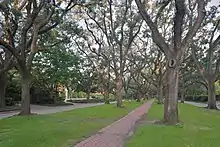
History
Broadacres Historic District | |
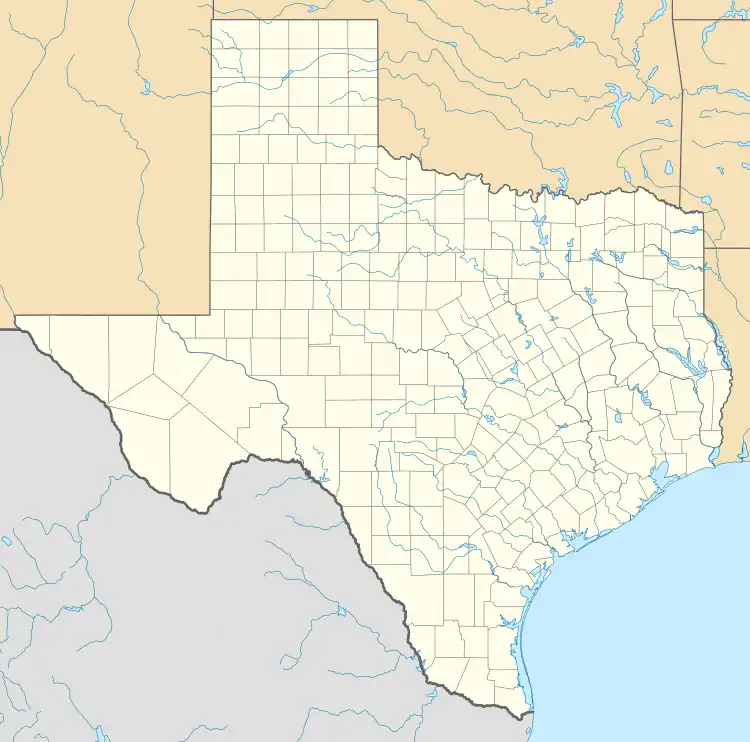  | |
| Location | 1300-1506 North Blvd. and 1305-1515 South Blvd., Houston, Texas |
|---|---|
| Coordinates | 29.727°N 95.397°W |
| Area | 34.2 acres (13.8 ha) |
| Architect | Birdsall Briscoe, John F. Staub |
| Architectural style | Colonial Revival, Tudor Revival, Mission/Spanish Revival |
| NRHP reference No. | 80004128[5] |
| Added to NRHP | April 16, 1980 |
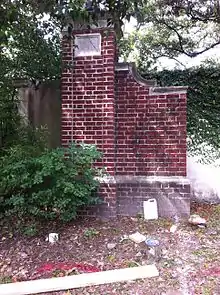
Broadacres was developed by prominent Houston attorney and banker Captain James A. Baker in cooperation with his son, attorney James A. Baker, Jr., in the early 1920s.[6] Baker, Sr. had purchased a 32-acre (13-hectare) parcel of property north of Rice University – and close to the burgeoning new Museum District – in 1908.[6] In 1922, his son and seventeen other investors purchased the land, which had been subdivided into 26 lots, and began constructing infrastructure and the first set of homes.[6] Kate Sayen Kirkland, author of James A. Baker of Houston, 1857-1941, said that "the Bakers conceived their Broadacres enclave as a public amenity distinguished by fine architecture and distinctive planning but limited in ownership to personal and professional friends invited to invest in the project."[7] William Ward Watkin, a prominent Houston architect, devised the master plan for the development; Watkin, Birdsall P. Briscoe, and John Staub served as architects for several of the houses.[6] The families who had houses built in Broadacres were not singular architectural patrons.[8]
Construction in Broadacres ceased during the Great Depression. James A. Baker, Jr. never lived in Broadacres, because he believed he would be unable to afford a $20,000 (about $333,738 today) down payment for a lot.[9] By the 1930s, Broadacres "collectively displayed its residents as a Houston upper class," according to Rice University architectural historian Stephen Fox.[8]
In 1980, the family of Gus Sessions Wortham, a local businessman and philanthropist, donated his former house to the University of Houston System for use as the chancellor's residence.[10] The three-storey house, which sits on 1.82 acres (7,400 m2) of land, was constructed by oilman Frank Sterling and was the most expensive in the neighborhood upon its completion in 1927.[10] The chancellor is required by contract to live at the Wortham House.[11] Only the second floor of the residence is reserved for the chancellor; the first and third floors are reserved for artwork and public events.[10] It is a contributing property to the Broadacres district. It was scheduled to undergo a renovation in 2017.[12] As of 2009 the value was about $6 million.[13]
The Broadacres Historic District, which includes 18 contributing buildings at 1300-1506 North Blvd. and 1305-1515 South Blvd., was listed on the National Register of Historic Places in 1980. It includes works designed by architects Birdsall Briscoe and John F. Staub.[5]
Cityscape
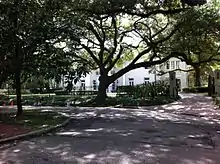
Kate Sayen Kirkland, author of James A. Baker of Houston, 1857-1941, said "Typical of the finest homes being constructed in Houston during the 1920s, the houses in Broadacres represent the eclectic style favored by the country house movement prevalent in that era."[14] Stephen Fox, author of The Country Houses of John F. Staub, said that in the 1920s "the entire neighborhood of Broadacres attained a collective identity that emphasized—through the beauty and decorum of individual houses and their systematic integration into a hierarchical landscape order that moved rhythmically measured sequences from the space of each country house, to its garden, to the space of the community, to the space of the planned garden city— the discernment, authority and what [Richard L. Bushman, a cultural historian] called "radiance" of its residents."[8] Fox said that "[i]t is the extraordinary collective impact that Broadacres's landscape still exerts that makes it such an instructive example of how elite community was socially constructed in Houston through architecture and landscape architecture during the 1920s."[8]
Education
Broadacres is within the Houston Independent School District.[15] Zoned schools include Poe Elementary School (located in Boulevard Oaks),[16] Lanier Middle School (located in Neartown),[17] and Lamar High School (located in Upper Kirby).[18]
Notable residents
- Renu Khator (Chancellor of the University of Houston System and President of the University of Houston)[11]
- William P. Hobby (Lieutenant Governor of Texas)[19]
Gallery
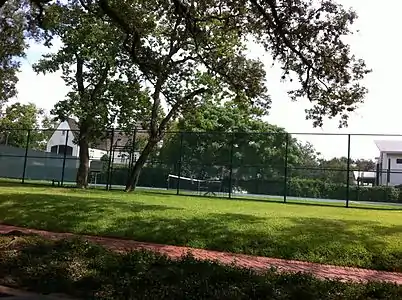 Broadacres Park
Broadacres Park
References
- Fox, Stephen. Color photography by Richard Cheek. The Country Houses of John F. Staub. Texas A&M University Press, 2007. 1585445959, 9781585445950.
- Kirkland, Kate Sayen. James A. Baker of Houston, 1857-1941. Texas A&M University Press, September 1, 2012. ISBN 1603448004, 9781603448000.
Notes
- "Civic Association Architectural Review/Deed Restriction Contacts Archived 2007-07-03 at the Wayback Machine." Boulevard Oaks. Retrieved on December 25, 2012.
- Cook, Allison. "A posh pleasure in Southampton / Antica Osteria serves Italian comfort food in a cozy setting." Houston Chronicle. Thursday January 20, 2005. Dining p. 6. Retrieved on November 20, 2012.
- Nicholson, Heather (April 9, 2010). "Boulevard Oaks planted its roots in 1920s, '30s". Houston Chronicle. Retrieved May 19, 2017.
- Rose, Cheryl P. (April 13, 2013). "Residents of Boulevard Oaks believe in preservation". Houston Chronicle. Retrieved May 19, 2017.
- "National Register Information System". National Register of Historic Places. National Park Service. July 9, 2010.
- "Broadacres". Historic Preservation Manual. City of Houston Planning and Development Department. 2013. Retrieved May 19, 2017.
- Kirkland, p. 297.
- Fox, p. 21.
- Kirkland, p. 299.
- "Wortham House". University of Houston. Retrieved May 19, 2017.
- "U of H chancellor living large Archived 2011-10-28 at the Wayback Machine." KTRK-TV. Saturday May 9, 2009. Retrieved on November 20, 2012.
- Lindsey, Shawn (April 18, 2017). "Historic UH System Property to Undergo Critical Repairs". University of Houston. Retrieved July 25, 2019.
- "U of H chancellor living large". KTRK-TV. May 9, 2009. Retrieved July 25, 2019.
- Sayen, p. 298.
- "Broadacres" (JPG, Archive, PDF, Archive - Harris County Block Book. Retrieved on November 20, 2012.
- "Poe Elementary Attendance Zone." Houston Independent School District. Retrieved on July 29, 2019.
- "Lanier Middle Attendance Zone." Houston Independent School District. Retrieved on July 29, 2019.
- "Lamar High School Attendance Zone." Houston Independent School District. Retrieved on July 29, 2019.
- Milling, T.J. "Tempers, taxes hit the roof/Southampton owners claiming cronyism." Houston Chronicle. Friday August 23, 1991. A25. Retrieved on November 20, 2012.
External links
- Map of Broadacres from the BOCA deed restrictions
- Harris County government block book map for Broadacres: JPG format, PDF format
- Wortham House - Conrad N. Hilton College, University of Houston
